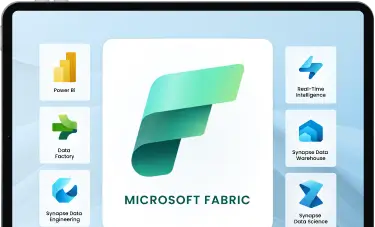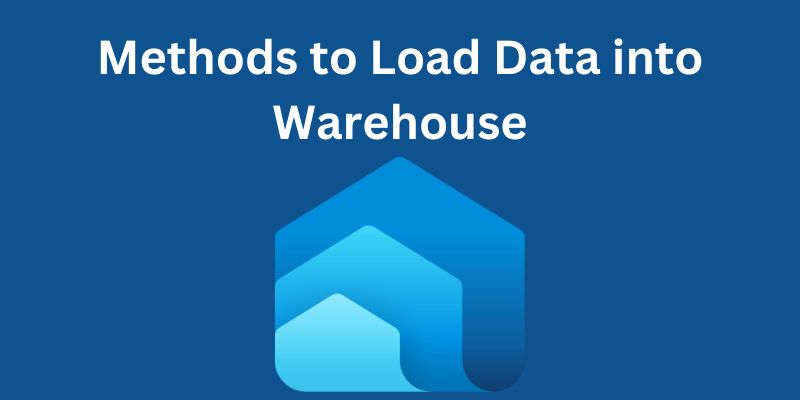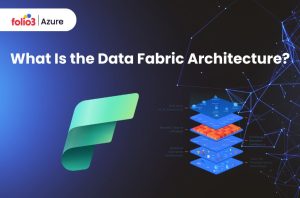Table of Contents
ToggleIn the dynamic landscape of data management, a robust data warehouse can be the bedrock that businesses rely on to make critical decisions. With the emergence of cloud-based solutions, the prowess of data warehouses has expanded beyond storage, transforming into comprehensive platforms that offer rich analytics, ease of use, and scalability.
Microsoft, a global technology leader, has ventured into this domain with Microsoft Fabric, a suite that offers a cohesive data warehouse experience. In this in-depth guide, we’ll walk you through the process of building a data warehouse with Microsoft Fabric, from inception to implementation and beyond.
What is Microsoft Fabric Data Warehouse?

Microsoft Fabric Data Warehouse is a powerful cloud-based service that blends massive scale and modern architecture with features that enable simple, yet sophisticated, data storage and processing.
It’s a part of the Microsoft Azure ecosystem, designed to elevate your data warehousing capabilities to the next level, leveraging the Azure Data Lake Storage and Azure Databricks technologies. Whether you’re dealing with petabytes or terabytes of data, Fabric Data Warehouse promises speed, security, and insights.
Steps to Build Microsoft Fabric Data Warehouse
Here are the 9 steps to create Microsoft Fabric Data Warehouse:
Step 1: Define Your Data Warehouse Objectives
Before you deploy any tool, it’s critical to have clarity on your objectives. Understanding your business’s data requirements, including the type of data, volume, and performance expectations, sets the stage for a dedicated structure that makes insights easily accessible.
Step 2: Design Your Data Model
A well-designed data model is the blueprint for a successful data warehouse. With Microsoft Fabric, consider factors like table distribution, indexing strategies, and query optimization to ensure performance and manageability are at their peak.
Step 3: Set Up Your Azure Environment
Create an Azure account if you don’t have one and set up the necessary components, including Azure Data Lake Storage and Azure Databricks, which will integrate with your Fabric Data Warehouse. Azure’s resource templates can expedite this process.
Step 4: Build Your Data Warehouse
Leverage the Azure portal or compatible tools to create your Fabric Data Warehouse, where you’ll define the servers, databases, and other elements. Consider the scale, choosing between options like On-Demand and Provisioned, based on your usage patterns and budget.
Step 5: Load Data Into Your Warehouse
Utilize various Azure services to bring data into your warehouse. Options include Azure Data Factory for ETL processes, native Azure services for direct loading, or third-party integrations to ensure seamless data ingestion.
Step 6: Implement Security and Compliance Measures
Craft a comprehensive data security strategy that implements role-based access controls, encryption, and monitoring. Ensure you comply with industry regulations and best practices to maintain the integrity and privacy of your data.
Step 7: Optimize for Performance
Fine-tune your environment by monitoring and adjusting distribution and indexing where needed. Use Azure’s built-in monitoring tools to identify bottlenecks and optimize for performance.
Step 8: Establish Analytics and Reporting
Integrate your preferred analytics tools with Fabric Data Warehouse to harness insights. Whether it’s through Power BI, Azure Analysis Services, or other solutions, ensure a seamless connection for end-users to access and interact with the data.
Step 9: Incorporate Continuous Improvement
A data warehouse that doesn’t evolve becomes obsolete. Regularly assess your data warehouse for performance, new data sources, and evolving business needs. Keep an eye on feature updates from Microsoft to incorporate advancements swiftly.
Accelerate smart decisions with Microsoft Fabric's unified data and AI analytics.

Methods to Load Data into Warehouse
Data loading is a pivotal process in the data warehousing workflow. Microsoft Fabric provides several methods to load data, each with its own set of benefits and use cases.
1. Data Pipelines
Azure Data Factory is Azure’s answer to an end-to-end data integration solution that orchestrates and automates data movement and data transformation. With connectors for over 90 data sources, Data Factory simplifies the creation of pipelines that pull data from various services into your Fabric Data Warehouse.
2. Dataflows (Gen 2)
Azure Data Factory’s Mapping Data Flow is a visually designed data transformation service that enables full Extract, Transform, Load (ETL) capabilities without the need to code. This next-gen Dataflow supports large data volumes and complex transformations, integrating seamlessly with the Fabric Data Warehouse.
3. SQL Commands
For direct loading, nothing beats the speed of SQL-based commands. By running SQL scripts that leverage the power of T-SQL and polybase to load data from structured or semi-structured sources, you can achieve real-time(ing) data loading into your data warehouse.
Methods to Read Data From the Warehouse
Once your data is in the warehouse, it’s time to derive value from it. Microsoft Fabric offers multiple avenues for reading and analyzing your data, ensuring that no matter your preferred method, you can access insights effortlessly.
1. Power BI
Power BI is a suite of business analytics tools that deliver insights throughout your organization. With Power BI, you can connect to hundreds of data sources, simplify data prep, and drive ad hoc analysis. The direct query capability allows for real-time analytics of data residing in your Fabric Data Warehouse.
2. Azure Analysis Services
Azure Analysis Services is a fully managed platform-as-a-service (PaaS) that provides enterprise-grade analytics engines for BI and advanced analytics solutions. It connects to your Fabric Data Warehouse, allowing for interactive analyses, and can be integrated into Power BI, Excel, and other data tools seamlessly.
3. Custom Applications
Utilize the power of REST APIs to build custom applications and reports that source data from your Fabric Data Warehouse. This method provides ultimate flexibility, especially in scenarios where you need a highly tailored analytical environment.
Conclusion
Building a data warehouse with Microsoft Fabric goes beyond just tech implementation; it’s a strategic move that aligns your data framework with modern business needs for scalability and flexibility. By following this manual and using the available tools and features, you’re on track to unlock your data’s full potential.
This strategy promotes a data-driven decision-making culture, pushing your business forward. Remember, the work doesn’t stop at deployment. Being adaptable and committed to continuous improvement is key to ensuring your data warehouse meets your organization’s changing needs.
Folio3 empowers your business to make well-informed decisions, gain essential insights, and optimize operations through a solid, adaptable data warehousing solution. We take on the intricate work of selecting the perfect platform, crafting detailed data models, and building a tailor-made DW that addresses your specific needs, allowing you to concentrate on pursuing strategic business goals.




